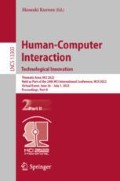Abstract
Human-robot interaction has played an increasingly significant role in more recent research involving the Theory of Mind (ToM). As the use of robot facilitators increases, questions arise regarding the implications of their involvement in a research setting. This work addresses the effects of a humanoid robot facilitator in a ToM assessment. This paper analyzes subjects’ performances on tasks meant to test ToM as those tasks are delivered by human or robot facilitators. Various modalities of data were collected: performance on ToM tasks, subjects’ perceptions of the robot, results from a ToM survey, and response duration. This paper highlights the effects of human-robot interactions in ToM assessments, which ultimately leads to a discussion on the effectiveness of using robot facilitators in future human-subject research.
Access this chapter
Tax calculation will be finalised at checkout
Purchases are for personal use only
References
Tironi, A., Mainetti, R., Pezzera, M., Borghese, N.A.: An empathic virtual caregiver for assistance in exer-game-based rehabilitation therapies. In: 2019 IEEE 7th International Conference on Serious Games and Applications for Health (SeGAH), pp. 1–6. IEEE (2019)
Ko, S., et al.: The effects of robot appearances, voice types, and emotions on emotion perception accuracy and subjective perception on robots. In: Stephanidis, C., Kurosu, M., Degen, H., Reinerman-Jones, L. (eds.) HCII 2020. LNCS, vol. 12424, pp. 174–193. Springer, Cham (2020). https://doi.org/10.1007/978-3-030-60117-1_13
Premack, D., Woodruff, G.: Does the chimpanzee have a theory of mind? Behav. Brain Sci. 1(4), 515–526 (1978)
Thellman, S., Silvervarg, A., Ziemke, T.: Some adults fail the false-belief task when the believer is a robot. In: Companion of the 2020 ACM/IEEE International Conference on Human-Robot Interaction, 479–481 (2020)
Dissing, L., Bolander, T.: Implementing theory of mind on a robot using dynamic epistemic logic. IJCA I, 1615–1621 (2020)
Cadinu, M.R., Kiesner, J.: Children’s development of a theory of mind. Eur. J. Psychol. Educ. 15(2), 93–111 (2000)
Wellman, H.M., Cross, D., Watson, J.: Meta-analysis of theory-of-mind development: the truth about false belief. Child Dev. 72(3), 655–684 (2001)
Bernstein, D.M., Thornton, W.L., Sommerville, J.A.: Theory of mind through the ages: older and middle-aged adults exhibit more errors than do younger adults on a continuous false belief task. Exp. Aging Res. 37(5), 481–502 (2011)
Pardini, M., Nichelli, P.: Age-related decline in mentalizing skills across adult life span. Exp. Aging Res. 35, pp. 98–106 (2009)
Sullivan, S., Ruffman, T.: Social understanding: how does it fare with advancing years? Br. J. Psychol. 95(1), 1–18 (2004)
Wimmer, H., Perner, J.: Beliefs about beliefs: representation and constraining function of wrong beliefs in young children’s understanding of deception. Cognition 13(1), 103–128 (1983)
Ward, T., et al.: False-belief task. In: Encyclopedia of Autism Spectrum Disorders, pp. 1249–1249 . Springer, New York (2013). https://doi.org/10.1007/978-1-4419-1698-3_91
Gopnik, A., Astington, J.W.: Children’s understanding of representational change and its relation to the understanding of false belief and the appearance-reality distinction. Child Development, pp. 26–37 (1988)
Baron-Cohen, S., Leslie, A.M., Frith, U.: Does the autistic child have a “theory of mind’’? Cognition 21(1), 37–46 (1985)
Hutchins, T.L., Prelock, P.A., Lewis, L.: Technical Manual of the Theory of Mind Inventory: Self Report-Adult (ToMI:SR-A). Unpublished Manuscript. Available at theoryofmindinventory.com (2019)
Arkoudas, K., Bringsjord, S.: Toward formalizing common-sense psychology: an analysis of the false-belief task. In: Pacific Rim International Conference on Artificial Intelligence. Springer (2008) 17–29. https://doi.org/10.1007/978-3-540-89197-0_6
Breazeal, C., Gray, J., Berlin, M.: An embodied cognition approach to mindreading skills for socially intelligent robots. Int. J. Robot. Res. 28(5), 656–680 (2009)
Sindlar, M.P., Dastani, M.M., Dignum, F., Meyer, J.-J.C.: Mental state abduction of BDI-based agents. In: Baldoni, M., Son, T.C., van Riemsdijk, M.B., Winikoff, M. (eds.) DALT 2008. LNCS (LNAI), vol. 5397, pp. 161–178. Springer, Heidelberg (2009). https://doi.org/10.1007/978-3-540-93920-7_11
Baratgin, J., Dubois-Sage, M., Jacquet, B., Stilgenbauer, J.L., Jamet, F.: Pragmatics in the false-belief task: let the robot ask the question! Front. Psychol. 11, 3234 (2020)
Haring, K.S., Matsumoto, Y., Watanabe, K.: How do people perceive and trust a lifelike robot. In: Proceedings of the World Congress on Engineering and Computer Science, vol. 1, Citeseer (2013)
Bartneck, C., Kulić, D., Croft, E., Zoghbi, S.: Measurement instruments for the anthropomorphism, animacy, likeability, perceived intelligence, and perceived safety of robots. Int. J. Soc. Robot. 1(1), 71–81 (2009)
Campbell, D. et al.: Theory of mind. In: Encyclopedia of Autism Spectrum Disorders, pp. 3111–3115. Springer, New York (2013). https://doi.org/10.1007/978-1-4419-1698-3
Mori, M., MacDorman, K.F., Kageki, N.: The uncanny valley [from the field]. IEEE Robot. Autom. Mag. 19(2), 98–100 (2012)
Ho, C.C., MacDorman, K.F.: Revisiting the uncanny valley theory: Developing and validating an alternative to the Godspeed indices. Comput. Hum. Behav. 26(6), 1508–1518 (2010)
Lehmann, H., Rojik, A., Hoffmann, M.: Should a small robot have a small personal space? Investigating personal spatial zones and proxemic behavior in human-robot interaction (2020)
Thunberg, S.: Investigating the social influence of different humanoid robots. Undergraduate thesis, Linköping University (2017)
Acknowledgement
This material is based upon work supported by the National Science Foundation under Award No. IIS-1851591. Any opinions, findings, and conclusions or recommendations expressed in this material are those of the authors and do not necessarily reflect the views of the National Science Foundation.
Author information
Authors and Affiliations
Corresponding author
Editor information
Editors and Affiliations
Rights and permissions
Copyright information
© 2022 The Author(s), under exclusive license to Springer Nature Switzerland AG
About this paper
Cite this paper
Rabe, T., Callis, A., Zheng, Z., Heard, J., Bailey, R., Alm, C. (2022). Theory of Mind Assessment with Human-Human and Human-Robot Interactions. In: Kurosu, M. (eds) Human-Computer Interaction. Technological Innovation. HCII 2022. Lecture Notes in Computer Science, vol 13303. Springer, Cham. https://doi.org/10.1007/978-3-031-05409-9_41
Download citation
DOI: https://doi.org/10.1007/978-3-031-05409-9_41
Published:
Publisher Name: Springer, Cham
Print ISBN: 978-3-031-05408-2
Online ISBN: 978-3-031-05409-9
eBook Packages: Computer ScienceComputer Science (R0)

